Preliminary Risk Assessment of Dam Failure at the Location of the Cukaru Peki Deposit, Bor (Serbia)
Abstract
1. Introduction
- High environmental load—dam failure and leakage or escape of wastes, which frequently contain hazardous substances that can lead to permanent environmental pollution, and endanger the lives of the adjacent population; and
- Fragile stability—the finest fractions of deposited waste material are usually used for embankment filling. While, the construction process runs in parallel with mining operations so that each new layer rests on the previous one, not allowing enough time for consolidation.
2. Study Area
- Waterproofing of all landfills with HDPE foils to prevent both surface and groundwater pollution by seepage waters;
- Construction of a protective concrete channel around the landfills in order to prevent the inflow of torrential water into the landfills;
- Construction of overflow facilities and sufficiently large flood retention areas as protection against heavy rainfall;
- Positioning of facilities at a sufficient distance from larger settlements; and
- Installation of alarm and alert systems to warn the local population in case of dam failure.
3. Methodology
- 1.
- Estimation of the annual failure probability on the basis of calculated safety factors;
- 2.
- Forecasting of dam failure modes and flood wave spreading according to the worst-case scenarios;
- 3.
- Estimation of dam failure consequences, namely;
- (a)
- Estimating the number of human casualties;
- (b)
- Damage level estimates;
- (c)
- Impact assessment; and
- 4.
- Risk analysis and evaluation using a risk matrix.
3.1. Estimation of the Annual Failure Probability
- 1.
- Category I—Structures that are paid the greatest possible attention during design, construction and utilisation. Generally speaking, it may be expected that the structures from this category will have significant potential consequences if an accident happens.
- 2.
- Category II—Structures that have been designed, constructed and utilised in accordance with standard engineering procedures. Structures with usual properties belong to this category.
- 3.
- Category III—Structures that have not been designed in accordance with standards. This category includes certain temporary structures or structures with minor potential consequences in case of an accident.
- 4.
- Category IV—temporary structures with little or no engineer support.
3.2. Forecasting of Dam Failure Modes and Flood Wave Spreading According to the Worst-Case Scenarios
3.3. Estimation of Dam Failure Consequences
3.3.1. Estimating the Number of Human Casualties
- Flood severity;
- Warning time; and
- Understanding of flood severity.
3.3.2. Damage Level and Impact Assessment
3.4. Risk Analysis and Evaluation
4. Risk Assessment and Discussion of Results
4.1. Annual Failure Probability
4.2. Prediction of Dam Failure in the Worst-Case Scenario
- The largest spillage of accumulated material would occur from the flotation tailings storage site—5.9 Mm3 (about 70% of the total amount of the tailings disposed of at the storage site);
- In the event of a breach of the pyrite concentrate dam, 3.78 Mm3 (about 85% of the total amount of the diluted mixture disposed of at the storage site) would flow out, while in the event of breach of the drainage water dam, 15,000 m3 of water would flow out (about 36% of the total volume of water stored in the reservoir);
- The maximum wave flow occurs immediately after the formation of breach in the dams, after which the wave flow will be less turbulent; and
- The breach of dams occurs gradually.
4.3. Assessment of Consequences Caused by Dam Failure
4.3.1. Estimating the Number of Human Casualties
4.3.2. Estimating the Level of Damage
- Number of residential houses exposed to risk: 10;
- Damage to critical infrastructure (economy)—“Significant damage to at least one infrastructure facility”;
- Time required to restore damaged facilities “Up to 3 months”;
- Environmental damage “significant “; and
- Time required for restoration “several months”.
4.3.3. Assessing the Extent of Potential Impact
4.4. Risk Analysis and Evaluation
5. Conclusions
- Liquefaction as the most extreme type of dam failure with the shortest time of manifestation;
- Dam overtopping when stored material overflows the crest, which usually occurs as the consequence of an extreme inflow of precipitation into the storage site;
- Seismic instability of slopes due to high shear stress in the dam body; and
- Internal erosion.
Funding
Data Availability Statement
Conflicts of Interest
References
- Luino, F.; De Graff, J.V. The Stava mudflow of 19 July 1985 (Northern Italy): A disaster that effective regulation might have prevented. Nat. Hazards Earth Syst. Sci. 2012, 12, 1029–1044. [Google Scholar] [CrossRef]
- Panteleeva, M.; Chamova, R.; Radeva, N.; Romanova, H. Anthropogenic Disasters on Bulgarian Territory: Chemical Accidents on Land and at Sea. J. IMAB–Annu. Proceeding Sci. Pap. 2021, 27, 3718–3722. [Google Scholar]
- Rotta, L.H.S.; Alcantara, E.; Park, E.; Negri, R.G.; Lin, Y.N.; Bernardo, N.; Mendes, T.S.G.; Souza Filho, C.R. The 2019 Brumadinho tailings dam collapse: Possible cause and impacts of the worst human and environmental disaster in Brazil. Int. J. Appl. Earth Obs. Geoinf. 2020, 90, 102119. [Google Scholar] [CrossRef]
- Kovac, C. Cyanide spill threatens health in Hungary. BMJ Br. Med J. 2000, 320, 536. [Google Scholar] [CrossRef][Green Version]
- Grimalt, J.O.; Ferrer, M.; Macpherson, E. The mine tailings accident in Aznalcollar. Sci. Total Environ. 1999, 242, 3–11. [Google Scholar] [CrossRef]
- McDermott, R.K.; Sibley, J.M. The Aznalcóllar tailings dam accident—A case study. Min. Resour. Eng. 2000, 9, 101–118. [Google Scholar] [CrossRef]
- Directive 2006/21/EC of the European Parliament and of the Council of 15 March 2006 on the Management of Waste from Extractive Industries and Amending Directive 2004/35/EC—Statement by the European Parliament, the Council, and the Commission. Available online: https://eur-lex.europa.eu/legal-content/EN/TXT/?uri=CELEX%3A32006L0021 (accessed on 18 August 2021).
- Government of Western Australia, Department of Mines and Petroleum, Guide to the Preparation of a Design Report for Tailings Storage Facilities (TSFs). Available online: https://www.dmp.wa.gov.au/Documents/Safety/MSH_G_TSFs_PreparationDesignReport.pdf (accessed on 18 August 2021).
- Lyu, Z.; Chai, J.; Xu, Z.; Qin, Y.; Cao, J. A comprehensive review on reasons for tailings dam failures based on case history. Adv. Civ. Eng. 2019, 2019, 4159306. [Google Scholar] [CrossRef]
- Pytel, W. Risk assessment of mine tailings/waste surface ponds. In Proceedings of the First International Seminar on the Reduction of Risk in the Management of Tailings and Mine Waste, Perth, Australia, 29 September–1 October 2010; pp. 229–242. [Google Scholar]
- Singh, R.; Herza, J. Development of a preliminary risk assessment tool for a portfolio of TSFs with limited and uncollated dat—In Sustainable and Safe Dams around the World; CRC Press: Boca Raton, FL, USA, 2019; pp. 3420–3436. [Google Scholar]
- International Committee on Large Dams (ICOLD). Small Dams Design, Surveillance, and Rehabilitation–Bulletin No 143; ICOLD: Paris, France, 2011; Available online: https://fdocuments.in/document/icold-small-dams-sept-2011.html (accessed on 28 May 2021).
- Department of the Army—Office of the Chief of Engineers, Washington DC. Recommended Guidelines for Safety Inspection of Dams, No. ER 1110-2-106, 26 Sept. 1979. Available online: https://mde.state.md.us/programs/water/DamSafety/Documents/www.mde.state.md.us/assets/document/damsafety/COE/Guidelines%20for%20Safety%20Inspections%20of%20Dams.pdf (accessed on 28 May 2021).
- McLeod, H.; Murray, L. Tailings dam versus water dam, what is the design difference? In Proceedings of the ICOLD Symposium on Major Challenges in Tailings Dams, Paris, France, 15 June 2003; International Commission on Large Dams: Paris, France, 2003; Volume 15, p. 12. [Google Scholar]
- Jovanovic, M. Problems of Numerical Simulation of Flood Waves Caused by Tailings Dam Failure. In Proceedings of the South Congress, Budva, Montenegro; 1997. [Google Scholar]
- Blight, G.E. Geotechnical Engineering for Mine Waste Storage Facilities; CRC Press, Taylor & Francis Group: London, UK, 2009. [Google Scholar]
- Dalpatram, A. Estimation of dam break discharges. In Proceedings of the Workshop on Dam Break Analysis Applied to Tailings Dams, Denver, CO, USA, 25 August 2011. [Google Scholar]
- Decree on the Conditions and Procedure for Issuing a Permit for Waste Management, as Well as on the Criteria, Characterization, Classification, and Reporting on Mining Waste (Official Gazette No. 53/2017). Available online: https://www.pravno-informacioni-sistem.rs/SlGlasnikPortal/eli/rep/sgrs/vlada/uredba/2017/53/1/reg (accessed on 24 August 2021).
- Jovanović, M. Instructions for the Preparation of Technical Documentation on the Hydraulic Consequences of Tailings Dams Failures; Society for Large Dams of Serbia: Belgrade, Serbia, 2005. [Google Scholar]
- Mining and Metallurgy Institute Bor (MMI Bor). Detailed Mining Design—Mineral Processing and Disposal of Tailings and Pyrite Concentrate from Cukaru Peki Deposit—Upper Zone; Serbia Zijin Mining doo Bor: Bor, Serbia, 2020. [Google Scholar]
- Einstein, H.H. Landslide Risk Assessment Procedure. In Proceedings of the Fifth International Symposium on Landslides, Lausanne, Switzerland, 10–15 July 1988; Bonnard, C., Ed.; Balkema: Rotterdam, The Netherlands, 1988; Volume 2, pp. 1075–1090, ISBN 9061918391. [Google Scholar]
- Garatwa, W.; Bollin, C. Disaster Risk Management—A Working Concept. Deutsche Gesellschaft für Technische Zusammenarbeit (GTZ), Eschborn. 2002. Available online: http://www2.gtz.de/dokumente/bib/02-5001.pdf (accessed on 17 June 2021).
- Robertson, A.; Shaw, S. Failure Modes & Effects Analysis (FMEA). Infomine, Vancouver. 2003. Available online: http://generalpurposehosting.com/guides/http%20%20%20technology.infomine.com%20enviromine%20Issues%20cls_FMEA.pdf (accessed on 17 June 2021).
- Silva, F.; Lambe, T.W.; Marr, W.A. Probability and risk of slope failure. J. Geotech. Geoenviron. Eng. 2008, 134, 1691–1699. [Google Scholar] [CrossRef]
- Rocscience Inc. SLIDE 5.0, 2D Limite Equilibrium Slope Stability Analysis. Available online: www.roscience.com (accessed on 21 August 2021).
- Regulation on the Monitoring and Information System, Special Issue No. 1. 1990; “Official Gazette of the SRS”, National Assembly of the Republic of Serbia, Serbia.
- US Army Corps of Engineers, HEC-GeoRAS, GIS Tools for Support of HEC-RAS Using ArcGIS, Version 4, User’s Manual, Hydrologic Engineering Center, Davis, USA. Available online: https://www.hec.usace.army.mil/software/hec-georas/documentation/HEC-GeoRAS4_UsersManual.pdf (accessed on 24 August 2021).
- Ackerman, C.T. HEC-GeoRAS: Linking GIS to hydraulic analysis using ARC/INFO and HEC-RAS. In Hydrologic and Hydraulic Modeling Support with Geographic Information Systems; US Army of Corps: Davis, CA, USA, 2000. [Google Scholar]
- Graham, W.J. Risk-Based Dam Safety Prioritization—A Method for Easily Estimating the Loss of Life from Dam Failure, Draft; U.S. Department of Interior Bureau of Reclamation Dam Safety Office: Denver, CO, USA, 1999. Available online: https://www.usbr.gov/ssle/damsafety/TechDev/DSOTechDev/DSO-99-06.pdf (accessed on 28 May 2021).
- MBIE, Impact Summary: Regulatory Framework for Dam Safety, Ministry of Business, Innovation and Employment (MBIE), New Zealand. 2021. Available online: https://www.mbie.govt.nz/dmsdocument/13916-impact-summary-regulatory-framework-for-dam-safety-proactiverelease-pdf (accessed on 23 September 2021).
- Institute for Standardization of Serbia. Risk Management—Risk Assessment Techniques; SRPS EN IEC 31010:2019; European Standard: Belgrade, Serbia, 2019. [Google Scholar]
- Garvey, P.R.; Lansdowne, Z.F. Risk matrix: An approach for identifying, assessing, and ranking program risks. Air Force J. Logist. 1998, 22, 18–21. [Google Scholar]
- Working Group. The Tolerability of Risk from Nuclear Power Stations; No. CB (2)1635/11-12(01); Health and Safety Executive (HSE): London, UK, 1992. [Google Scholar]
- Jones-Lee, M.; Aven, T. ALARP—What does it really mean? Reliab. Eng. Syst. Saf. 2011, 96, 877–882. [Google Scholar] [CrossRef]
- Pike, H.; Khan, F.; Amyotte, P. Precautionary principle (PP) versus as low as reasonably practicable (ALARP): Which one to use and when. Process. Saf. Environ. Prot. 2020, 137, 158–168. [Google Scholar] [CrossRef]
- Institute for Standardization of Serbi. Dams—Technical Requirements for Design; SRPS.U.C5.020:1980; Pure National Standard: Belgrade, Serbia, 1980. [Google Scholar]
- Rico, M.; Benito, G.; Diez-Herrero, A. Floods from tailings dam failures. J. Hazard. Mater. 2008, 154, 79–87. [Google Scholar] [CrossRef] [PubMed]
- Concha Larrauri, P.; Lall, U. Tailings Dams Failures: Updated Statistical Model for Discharge Volume and Runout. Environments 2018, 5, 28. [Google Scholar] [CrossRef]
- Quelopana, H. Released Volume Estimation for Dam Break Analysis. Tailings Manag. 2019, 6, 1–12. [Google Scholar]
- Avramović, L.; Stevanović, Z.; Bugarin, M.; Jonović, R.; Marković, R.; Gardić, V.; Jonović, M.; Đorđević, J. Characterization of soil in the coastal area of the Bor River abstract. Zaštita Materijala 2016, 57, 378–382. [Google Scholar] [CrossRef]
- Milijasevic, D.; Milanovic, A.; Brankov, J.; Radovanovic, M. Water quality assessment of the Borska Reka River using the WPI (water pollution index) method. Arch. Biol. Sci. 2011, 63, 819–824. [Google Scholar] [CrossRef]
- Taguchi, G. Fault Tree Analysis of Slurry and Dewatered Tailings Management—A Framework. Ph.D. Dissertation, University of British Columbia, Vancouver, BC, Canada, 2014. [Google Scholar]
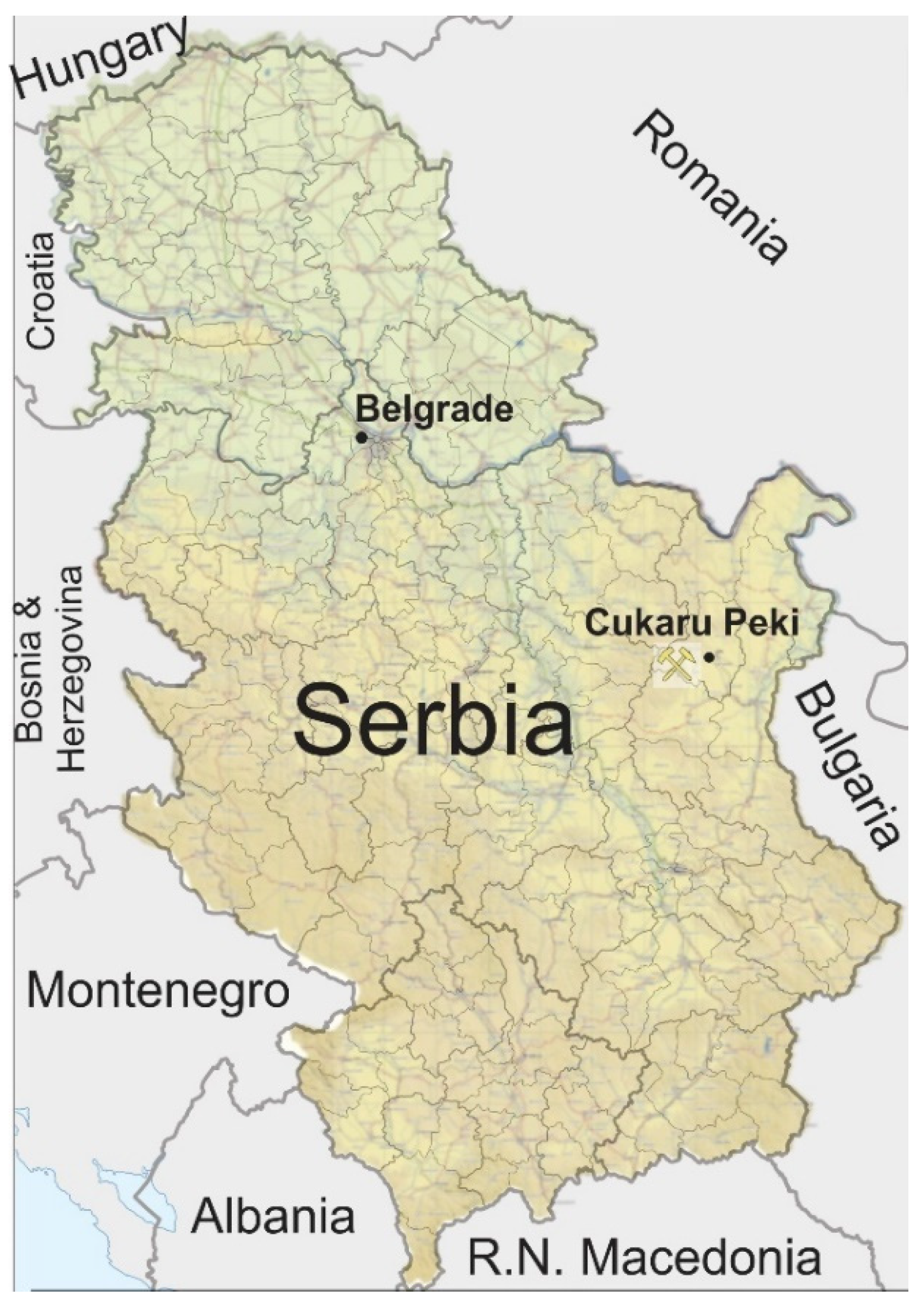
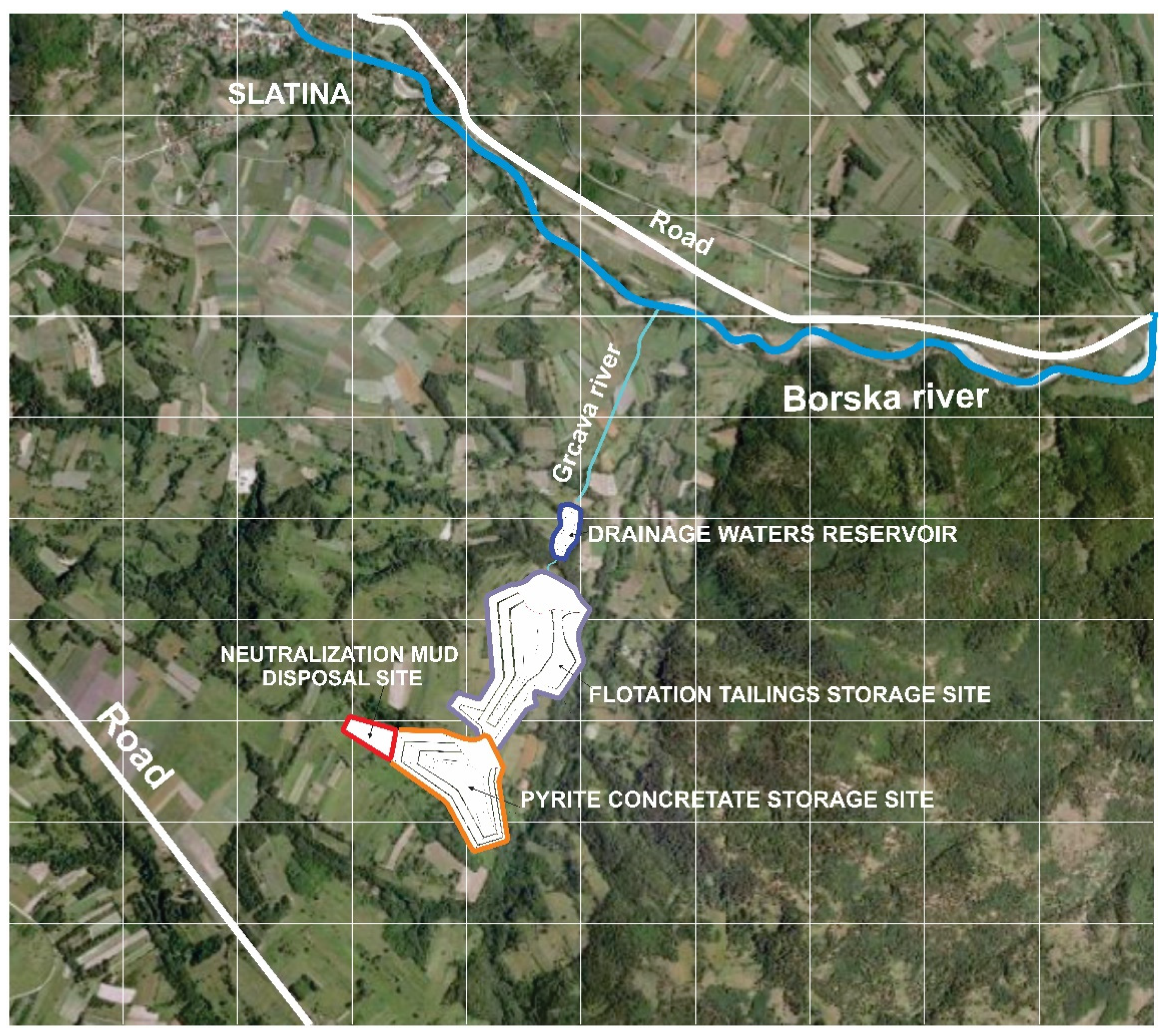
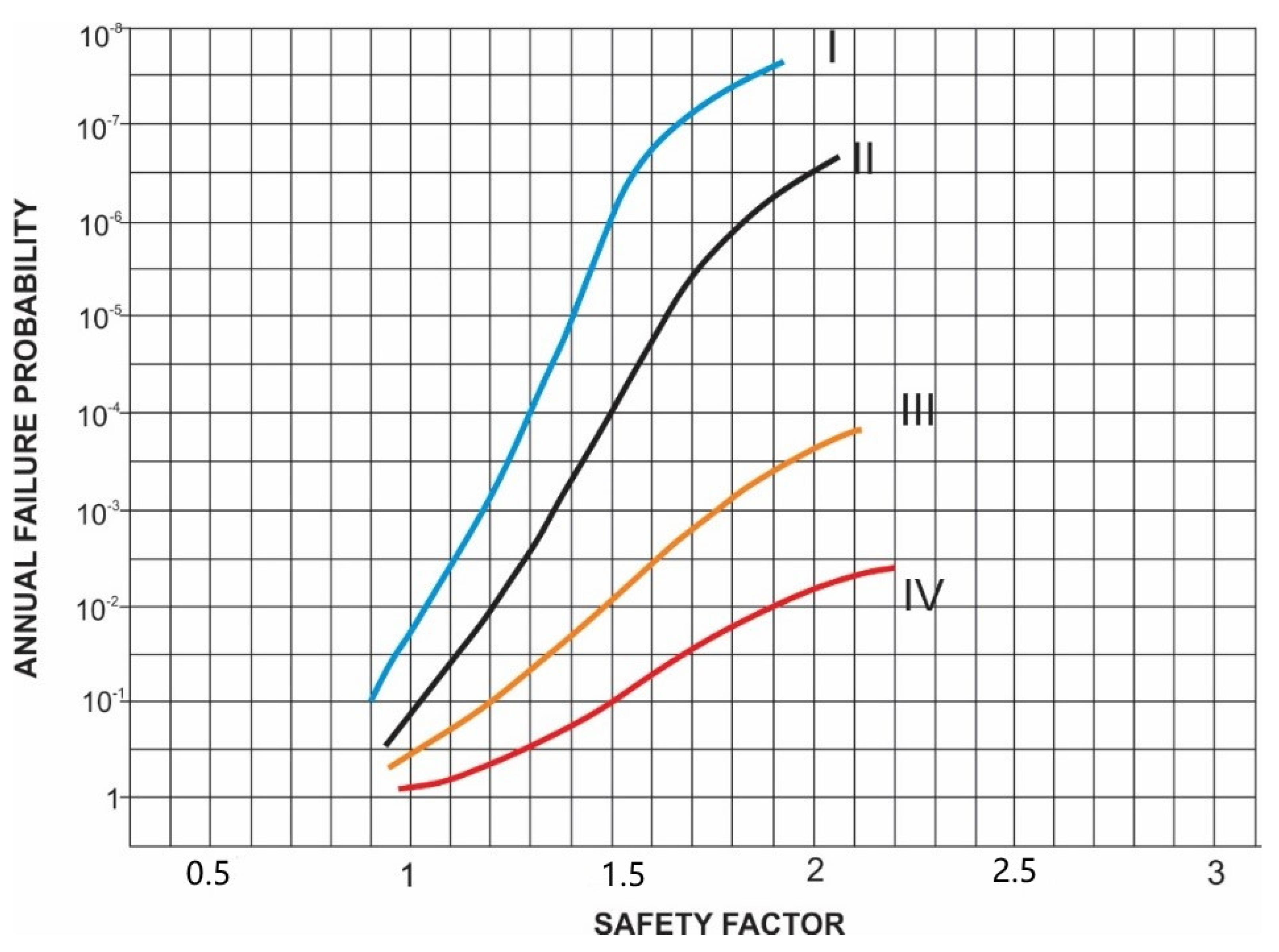
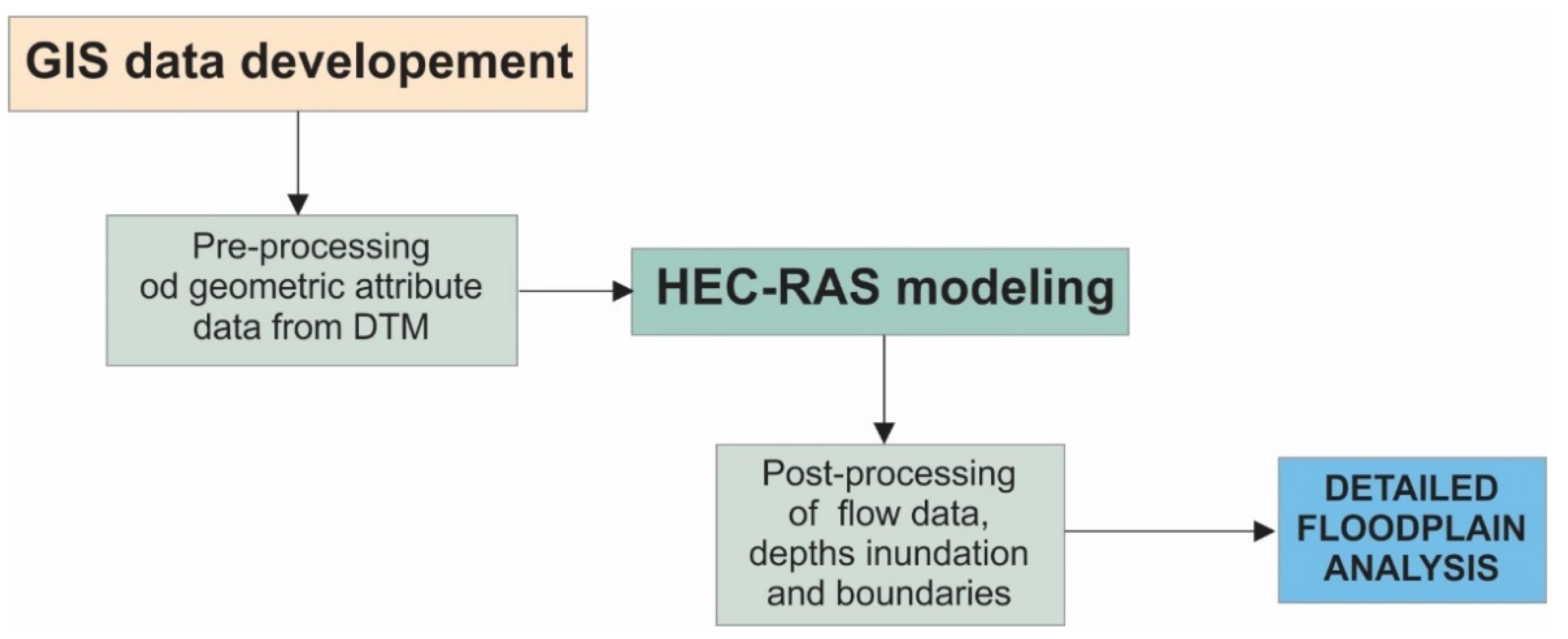
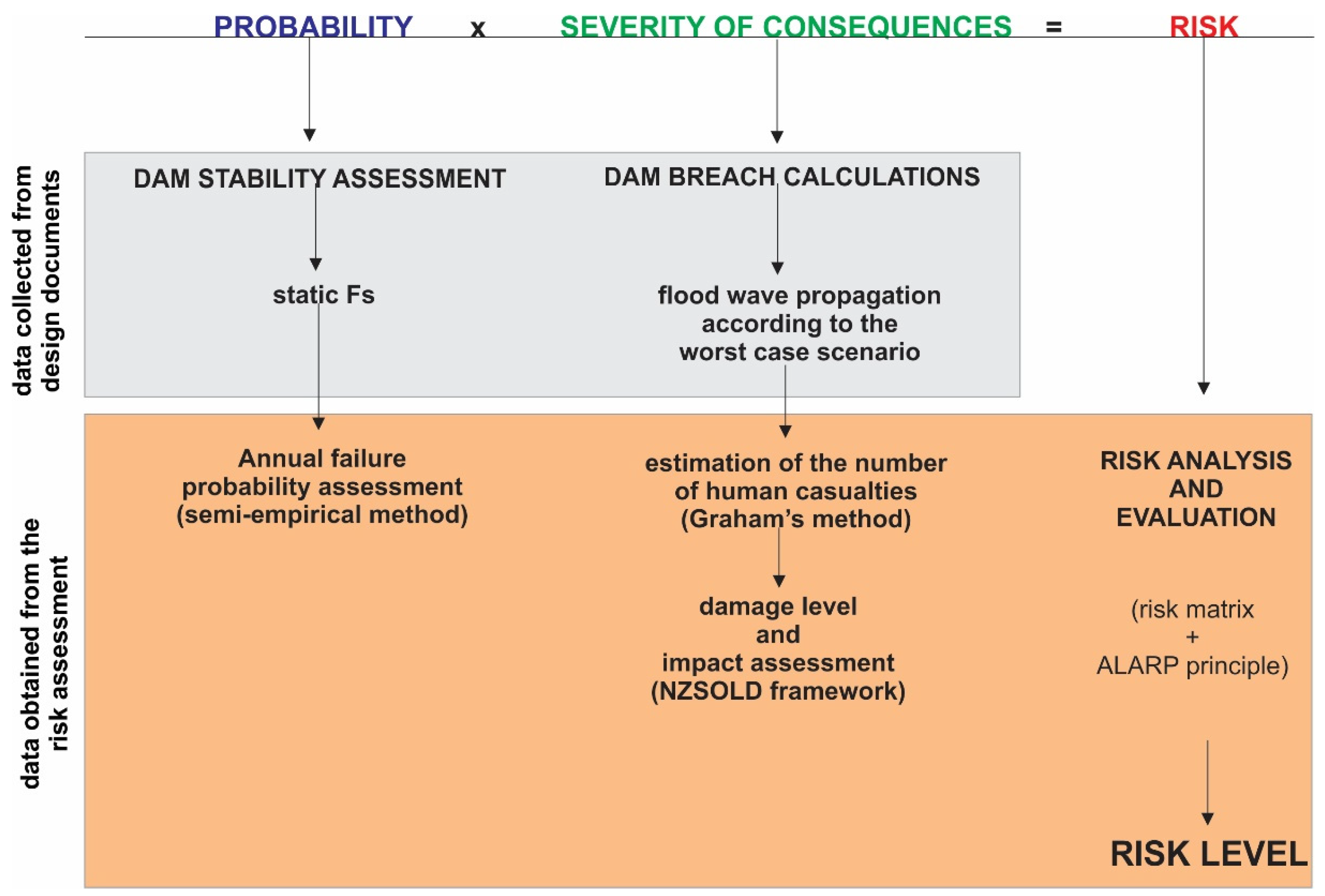
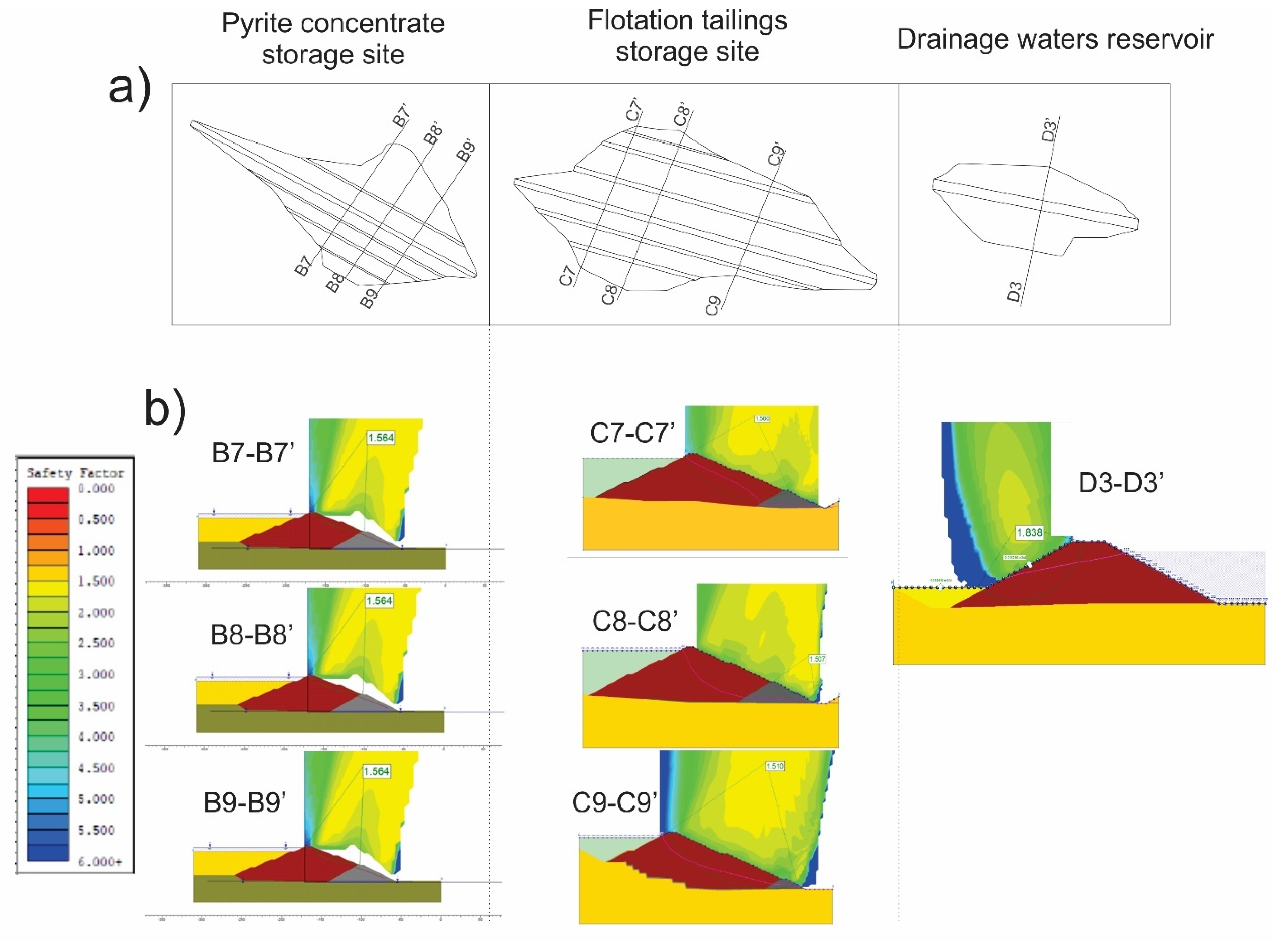
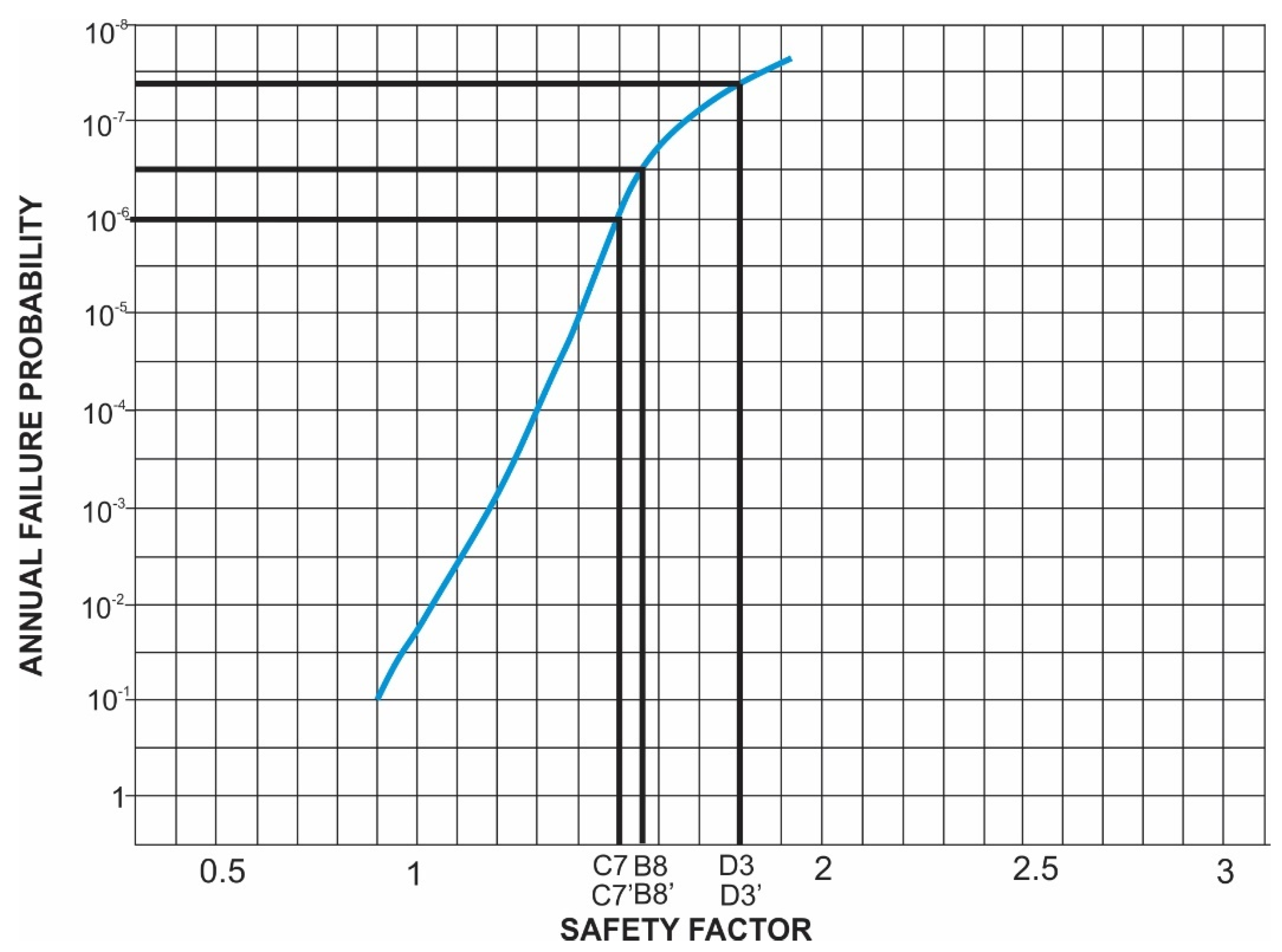

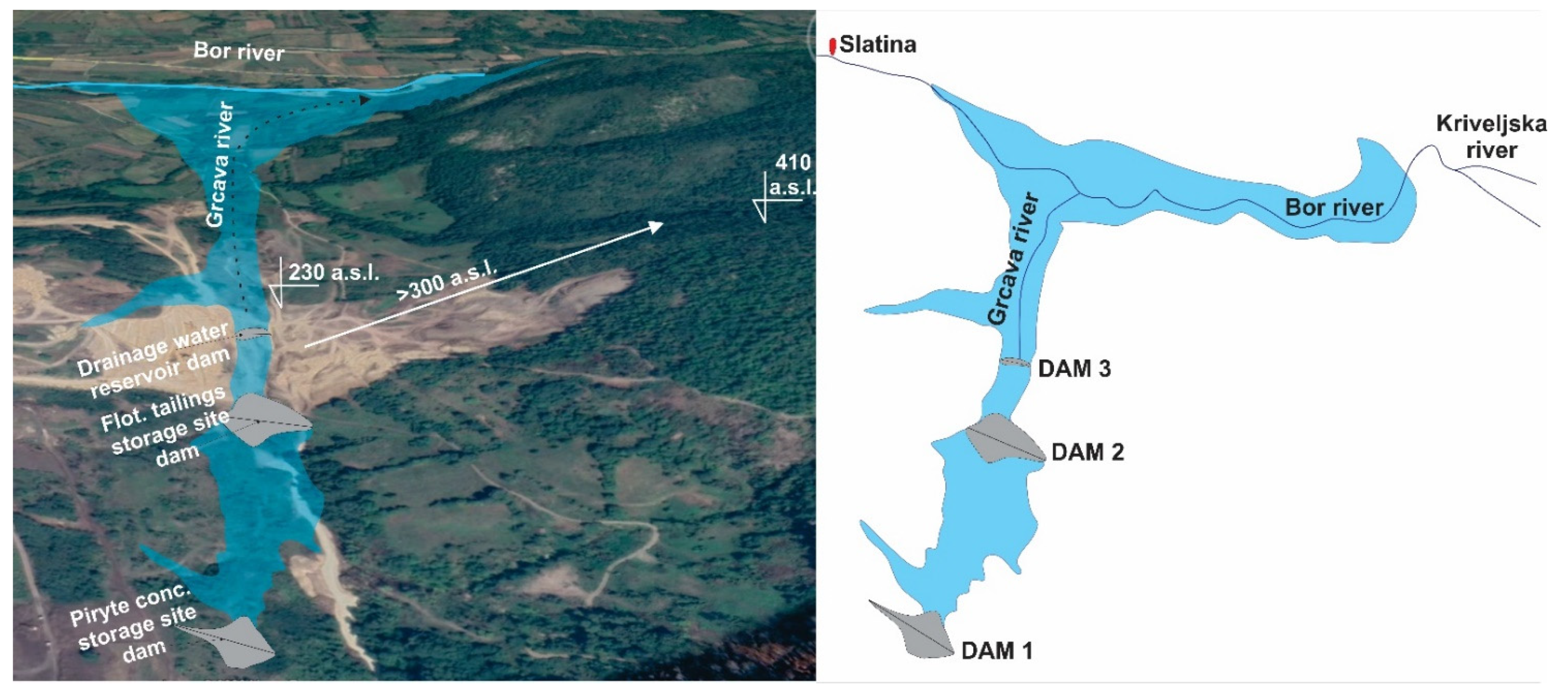
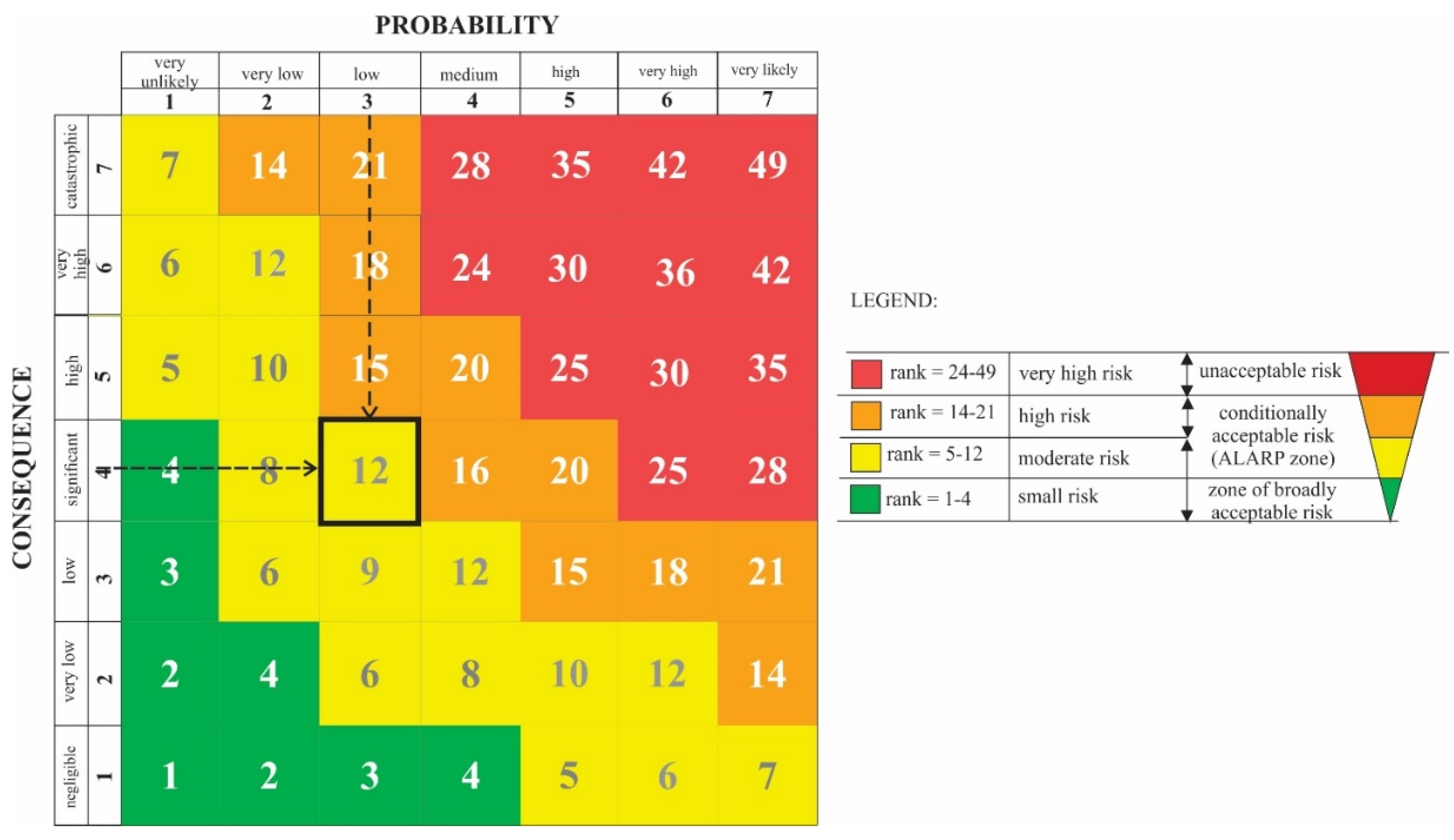
| Dam | Level of Upbuild, m a.s.l. | Height, m | Backfilling Level of Accumulation Area, m a.s.l. | Volume‚ × 103 m3 | Volume of Settling Pond, m3 | Service Life, Years |
|---|---|---|---|---|---|---|
| Pyrite concentrate storage site | 317 | 45 | 315 | 4431 | 31,400 | 12.5 |
| Flotation tailings storage site | 294 | 59 | 292 | 9672 | 31,400 | 11 |
| Drainage waters reservoir | 233 | 6 | 232 | 41 | doesn’t exist | 12 |
| Severity of Flood | Warning Time (min) | Understanding of Flood Severity | Mortality Rate (Human Casualty Rate) | |
|---|---|---|---|---|
| Average | Range | |||
| Large | Without warning | not applicable | 0.75 | 0.3–1.00 |
| 15 to 60 | incomplete complete | * No suitable data | ||
| More than 60 | Incomplete complete | |||
| Medium | Without warning | NA | 0.15 | 0.03–0.35 |
| 15 to 60 | Incomplete | 0.05 | 0.01–0.08 | |
| Complete | 0.02 | 0.005–0.04 | ||
| More than 60 | Incomplete | 0.03 | 0.005–0.06 | |
| Complete | 0.01 | 0.002–0.02 | ||
| Small | Without warning | NA | 0.01 | 0–0.02 |
| 15 to 60 | Incomplete | 0.007 | 0–0.015 | |
| Complete | 0.002 | 0–0.004 | ||
| More than 60 | Incomplete | 0.0003 | 0–0.0006 | |
| Complete | 0.0002 | 0–0.0004 | ||
| Damage Level | Residential Houses | Infrastructure 1 | Environment | Time Required for Restoration | |
|---|---|---|---|---|---|
| Damage | Time Required to Restore to Operation 2 | ||||
| Catastrophic | >50 houses destroyed 3 | Extensive damage to several major infrastructure facilities | >1 year. | Extensive damage | Many years |
| Major | 4–49 houses destroyed and a number of houses damaged | Extensive damage to more than one infrastructure facility | Up to 1 year. | Significant damage and high costs of restoration | Several years |
| Moderate | 1–3 houses destroyed and some damaged | Significant damage to at least one infrastructure facility | Up to 3 months | Significant damage but easily recoverable | Several months |
| Minimal | Minor damage | Minor damage to major infrastructure facilities | Up to 1 week | Short-term damage | From several days to several weeks |
| Damage Level | Population Exposed to Risk | |||
|---|---|---|---|---|
| 0 | 1–10 | 11–100 | 100 | |
| Catastrophic | High | High | High | High |
| Major | Medium | Medium/high (note 4) | High | High |
| Moderate | Low | Low/medium/high (note 3 and 4) | Medium/high (note 4) | Medium/high (note 2 and 4) |
| Minimal | Low | Low/medium/high (note 1, 3 and 4) | Low/medium/high (note 1, 3 and 4) | Low/medium/high (note 1, 3 and 4) |
| Dam | Profile | Fs | Allowed Fs According to SRPS U.C5 Standard for Static Load [36] |
|---|---|---|---|
| Pyrite concentrate storage site | B7-B7’ | 1.585 | ≥1.5 1 |
| B8-B8’ | 1.564 | ||
| B9-B9’ | 1.568 | ||
| Flotation tailings storage site | C7-C7’ | 1.500 | |
| C8-C8’ | 1.507 | ||
| C9-C9’ | 1.510 | ||
| Drainage waters reservoir | D3-D3’ | 1.838 | ≥1.3 2 |
| Quantity Value | Quality Value | Weight Factor |
|---|---|---|
| ≤1 × 10–2 | Very likely | 7 |
| 1 × 10–2 < x ≤ 1 × 10–3 | Very high | 6 |
| 1 × 10–3 < x ≤ 1 × 10–4 | High | 5 |
| 1 × 10–4 < x ≤ 1 × 10–5 | Medium | 4 |
| 1 × 10–5 < x ≤ 1 × 10–6 | Low | 3 |
| 1 × 10–6 < x ≤ 1 × 10–7 | Very low | 2 |
| ≥1 × 10–7 | Very unlikely | 1 |
Publisher’s Note: MDPI stays neutral with regard to jurisdictional claims in published maps and institutional affiliations. |
© 2021 by the author. Licensee MDPI, Basel, Switzerland. This article is an open access article distributed under the terms and conditions of the Creative Commons Attribution (CC BY) license (https://creativecommons.org/licenses/by/4.0/).
Share and Cite
Nišić, D. Preliminary Risk Assessment of Dam Failure at the Location of the Cukaru Peki Deposit, Bor (Serbia). Minerals 2021, 11, 1126. https://doi.org/10.3390/min11101126
Nišić D. Preliminary Risk Assessment of Dam Failure at the Location of the Cukaru Peki Deposit, Bor (Serbia). Minerals. 2021; 11(10):1126. https://doi.org/10.3390/min11101126
Chicago/Turabian StyleNišić, Dragana. 2021. "Preliminary Risk Assessment of Dam Failure at the Location of the Cukaru Peki Deposit, Bor (Serbia)" Minerals 11, no. 10: 1126. https://doi.org/10.3390/min11101126
APA StyleNišić, D. (2021). Preliminary Risk Assessment of Dam Failure at the Location of the Cukaru Peki Deposit, Bor (Serbia). Minerals, 11(10), 1126. https://doi.org/10.3390/min11101126






